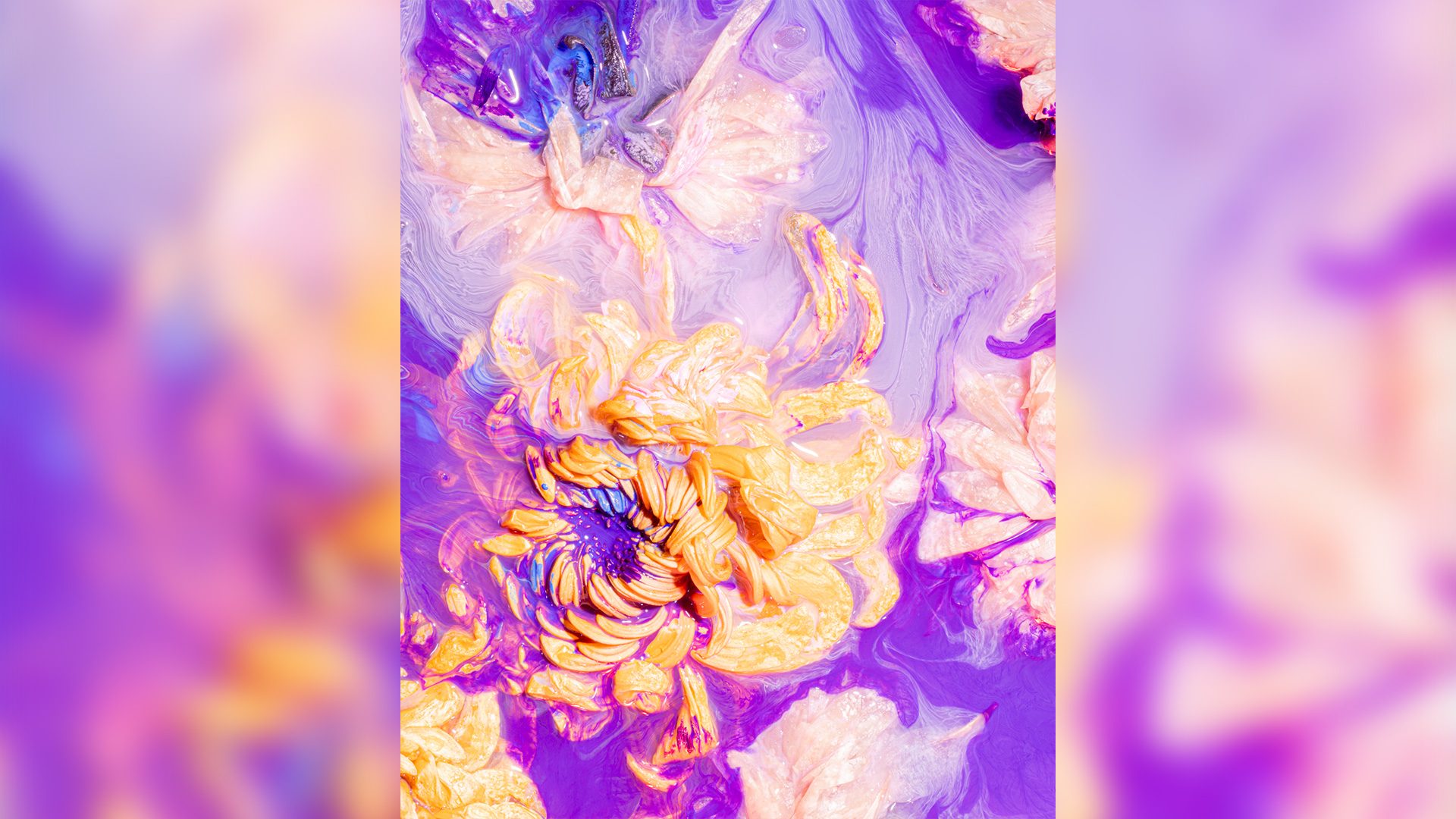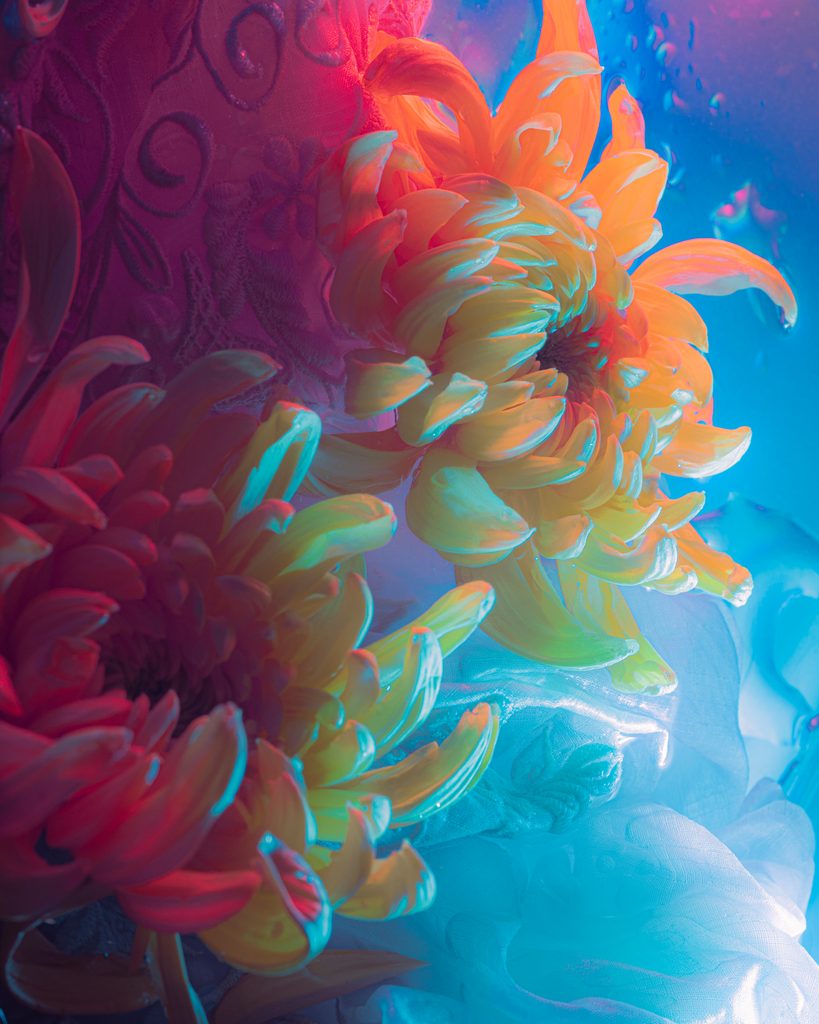SUMMARY
This is AI generated summarization, which may have errors. For context, always refer to the full article.

Sandra Dans is a photographer who works in both commercial production and fine art. Her series Dissolution – on view until January 15 at Chapter Coffee in UP Town Center – belongs to the latter category, despite being hung in the casual confines of a coffee shop in a shopping mall. Dans shares this space with photographer Johann Guasch, with whom she conceptualized the two-person show, Unearthed.
Essentially a series of still lives, Dans photographs the same set of chrysanthemums, in different states of dissolution in salt water, ice, and finally, paint – hence the title. In her artist statement, the subject of the series shifts from the flowers in the foreground to the water used to dissolve them, revealing what she refers to as “the paradox of water.” Through these drowned mums, Dans ruminates on relations between water and the living body; wherein water is both life force and poison.

Side by side with Guasch’s work, both photographers render the small and mundane (geodes for Guasch, flowers for Dans) as larger than life, playing with scale through the techniques that photography affords them. Zooming in on the surface of a geode, Guasch captures a mountain range, while Dans turns the petals of a chrysanthemum into a riverine system. What can be held in the palm of one’s hand becomes a full landscape. Where Guasch’s vistas, however, are precise and crisp, Dissolution playfully and unabashedly embraces wetness, bright colors, and surface-level techniques, all the while reminding us of decay and mortality.
The series of eight framed prints can also be seen as extensions of Dans’ previous work, Heirblooms – another experimental series of still lives she created as a tribute to her grandmothers; one of whom, Filipina painter Araceli Dans, is well-known for rendering similar subjects in a more classical vein.
When asked to describe the work, Dans is objective and methodical, but also irreverent; interjecting her own statement with “tl;dr: flower pretty, i take picture.” In taking the pretty, however, and subjecting it to the states of dissolution, Dans commits something more transgressive. “Pretty,” in this sense, is a term reclaimed, with the states of dissolution expanding the ways beauty can be captured, while firmly remaining within Dans’s millennial Lisa Frank-Magical Girl-infused aesthetic.

It is common knowledge in the contemporary art world that flowers are often deployed to convey the well-worn cliche that is “the beauty of nature.” The flower painting, while not necessarily maligned, is rarely taken seriously and often treated as shorthand for art that is merely decorative (with emphasis on merely). A number of practitioners are reintroducing how flowers are depicted and framed through photography, reclaiming and resisting the often sexist takes on the flower as subject (to this, one might recall the fairly recent collaboration between Shaira Luna and actress Liza Soberano).
The same can be said for her unapologetic adoption of the word “pretty.” Applied sparingly, if used at all, in contemporary art, “pretty” is often deemed as shorthand for vacuous and superficial. For as long as cultural discourse remains sexist and patriarchal, to call one’s work “pretty” is the fastest way to strip it of meaning.
In her monograph on filmmaker Sofia Coppola (known for lengthy films unpacking the gilded inner lives of girls and women), critic Anna Backman Rogers writes of the common use of “pretty” as a means to dismiss Coppola’s films. She quotes Rosalind Galt, whose seminal work Pretty: Film and the Decorative Image, examines this rejection of the term as descriptor, for its promise of “empty spectacle,” one that is “lacking in depth, seriousness, or complexity of meaning.” On the criticism of Coppola’s preoccupation with surface, Backman Rogers contends with how the imagery is often “denigrated as mere frippery – an insubstantial substitute for hard, scientifically rigorous, implicitly masculine knowledge.”

This equation of pretty with vacuous bears deeply misogynistic undertones, allowing us to diminish works for which “pretty” might be just one descriptor, in the process discrediting their creators. Patriarchy has conditioned us to believe that only certain images are worth taking seriously. The bright, the delicate, the fluffy, the visual equivalents of lace and puff pastry fall away from this category, forcing the likes of Dans to go their own way in an aggressively cis-hetero male photography establishment – which in turn also operates within a deeply patriarchal art world.
While this comes with certain opportunities, imagine how different our vocabulary for art and image-making might be if we considered these images beyond the fluff and fantasy on view; beyond the misconception that a pleasing exterior holds nothing beneath the surface. Wherever we are on the spectrum, we are taught to value and admire prettiness, but also to regard our attraction to it with caution. In many ways, this denigration of pretty comes from the same impulse driving reductive and misogynistic takes of otherwise successful and powerful women. It’s in the patriarchal urge to resist or outright disregard the feminine (or anything that is not cis-hetero male), as it goes against what we expect power to look like.

Dans’s Dissolution might portray the slowly dissolving life force of a flower, but it also reclaims space for the pretty, and all the baggage that term is saddled with. Through eight large-scale prints, the viewer sees how she plays with pretty and experiments with it before capturing and framing it on her own terms. – Rappler.com
Dissolution is on view as part of Unearthed: Photographs by Sandra Dans and Johann Guasch at Chapter Coffee, 2/f UP Town Center, Katipunan Avenue, Quezon City.
References:
Backman Rogers, Anna. Sofia Coppola: The Politics of Visual Pleasure. Berghahn Books, 2019.
Galt, Rosalind. Pretty: Film and the Decorative Image. Columbia University Press, New York, 2011.
Add a comment
How does this make you feel?
There are no comments yet. Add your comment to start the conversation.